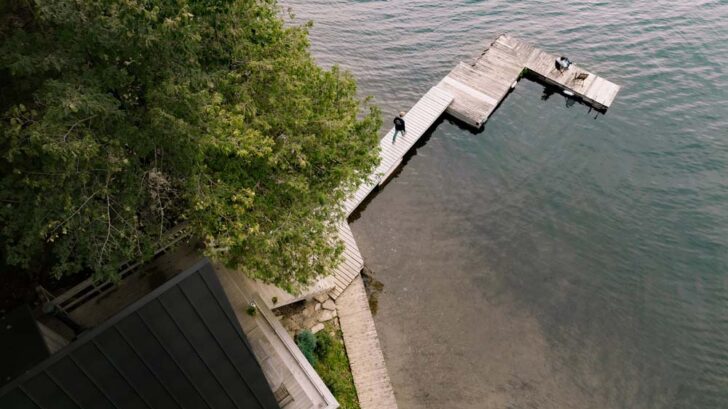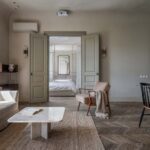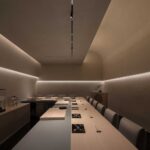
Matière Première Architecture and its affiliated construction company, Nu Drom have completed the renovation project of a 3-season cottage in Estrie, Canada. Using a simple brief that honored the A-frame typology while emphasizing an ecological approach, the architects created a series of spaces that promote the cottage’s juxtaposition with the water while optimizing the available space for better usage.


The owners of this 1950s property were drawn to the ever-popular A-frame cottage typology and desired to rebuild and rejuvenate the cottage into a 21st century residence. This unusual building, which can be found in the Eastern Townships, close to Montréal, is perched on an evergreen forest and its magnificent waterplane almost touches the water. The old cabin was effectively exposed to years of harsh Canadian winters because it was inaccessible during the long winter months.
The project’s goal was to house a series of fluid and relaxing spaces, as well as a close relationship to the lake. The architecture captures the natural landscape that unfolds beyond its structure in a beautiful way, which becomes fundamental to the living spaces by providing an intimate and cozy experience for its occupants. The A-frame silhouette creates playful spaces while always providing views of the lake. This unbroken relationship with the outside is maintained throughout the project, exposing the cycles and rhythms of the ever-changing weather.



The interior design emphasizes lighter tones in shades of white and sage to promote a relaxing atmosphere. It also incorporates casual furnishings, such as inviting rugs and linen accessories, to add warmth to the living spaces. The architects chose materials that are local, sustainable, and long-lasting, such as white pine flooring, exposed timber framing, and painted spruce boards. The exterior design emphasized stronger materials like natural white cedar siding, metal roofing, and aluminum windows. These materials contribute to the cabin’s controlled aging without jeopardizing its longevity.
RELATED: FIND MORE IMPRESSIVE PROJECTS FROM CANADA
Within its small footprint, the cottage incorporates multiple living spaces. The main large window in the A-frame was shifted toward the interior to accommodate a larger exterior dining area, followed by the living room and dining nook, all of which offer spectacular views of the lake through the large windows. A new stairway leading to a mezzanine was installed in a more discreet location at the back of the dining nook. It is nestled above the living room and provides a cozy reading net with a view of the lake while eliminating the need for a railing. The dining nook is adjacent to the compact kitchen, and a separate dormitory pavilion sits adjacent to the main cottage, providing more space for guests.







The steep and limited access to the site made construction difficult, with well over 150 steps required to reach the cottage. Difficult access to deliver new materials and remove existing materials steered the construction in an environmentally conscious direction, resulting in the recovery of as many existing materials as possible. This project motivated the clients to renovate the cottage meticulously and thoroughly in accordance with current building practices. To transport all construction materials to the site, a temporary cable crane was erected, while mature trees were protected along its path. The client stressed the importance of preserving all existing trees as well as revitalizing the lakefront. To promote organic renaturalization, indigenous plants from the area were planted along the shoreline.

Project information
Architect: Matière Première Architecture – www.matierepremierearchitecture.ca
Contractor: Nu Drom
Photographs: Ian Balmorel
Year: 2021-2022
Area: 75m2



